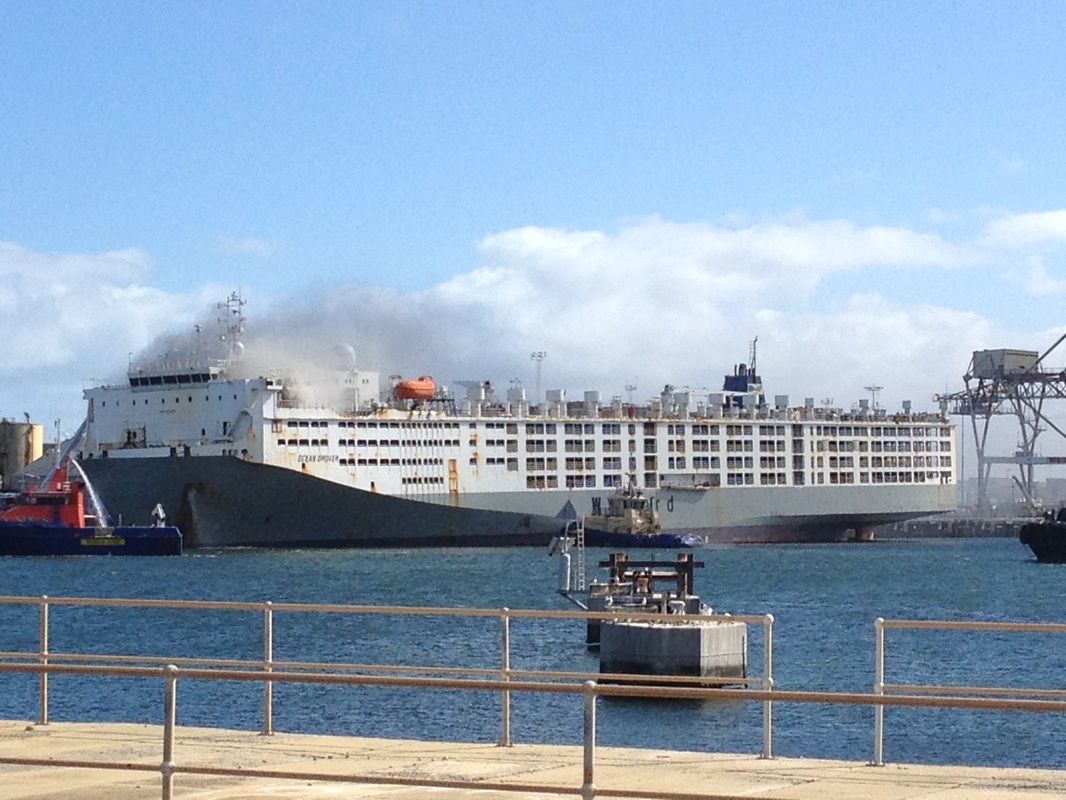|
If it's not time to end the live export trade, it is time to have independent vets on ships and independent auditing and monitoring of ESCAS.
Last night Lateline exposed further ESCAS breaches and these are seemingly ongoing in every importing country that independent investigators have been able to access. It's time! Check out our latest media release.
0 Comments
Approximately 40,000 sheep burned to death on the Farid Fares in 1980. 67,000 sheep burned to death at sea on the Uniceb in 1996. The Ocean Drover can carry 75,000 sheep. If today's fire had happened at sea then there is no doubt about the outcome: 75,000 sheep burned at sea in 2014 and one major live export disaster due to fire every 11.5 years.
Even in Port, firefighters from a huge number of units could not control the fire in this ship. Just another incident that highlights the inherent dangers in exporting Australian animals alive on ships. The Ocean Drover, with no sheep on board, is on fire in Fremantle Port. Burning for a few hours (at this stage). So, a temporary reprieve for 70,000 or so sheep (or 18,000 cattle) although questions have to be asked as to how they are going to be managed at the feedlot now that they are unlikely to be going anywhere soon.
Also spare a thought for the crew members who have been injured in the fire ... probably foreign workers far from home. The recent high mortality flight to Singapore is yet another high mortality flight to have occurred in the last year.
Whilst Ms Penfold of ALEC points out that there was only one other high mortality sheep flight in 2013, she conveniently didnt mention that since September 2013, there have now been at least four high mortality live export flights - yes two of the three (Reports 47 and 48) were cattle. So no high mortality flights at all between Feb 2010 and Sept 2013 but now at least four between September 2013 and early October 2014 So an unprecedented 13 months of high mortality air incidents it would seem and all somehow cite some failure in ventilation even if no mechanical problems found. Are planes suddenly breaking down all the time? Or are they perhaps being overstocked? Are the animals being left on the Australian airport tarmac in the full sun before they get on the plane (as shown in a photo sent anonymously to VALE)? Whatever the cause, these animals, 39.3% of them on one flight, suffered unacceptably. Watch this space and read the Mortality Investigation Reports 47-49. Well its not just the Gibb. The Report to the Commissioner of Soil and Land Conservation on the condition of the WA pastoral resource base 2013 found the following:
"The frequency of grasses of desirable perennial species is declining and... it appears that stocking rates are commonly excessive and rangeland is deteriorating as a result. That this decline is occurring during generally favourable seasons in some locations is particularly disturbing suggesting that the rangelands are unable to develop resilience during favourable seasons to assist in survival during less favourable seasons... This report indicates that ongoing rangeland degradation continues under present management on many leases and that such management is therefore not in accordance with Section 95 of the Land Administration Act 1997. Action to address this situation will not be simple but is necessary and should be immediate." So, there it is: West Australian land is being trashed. Consequences: environmental and animal welfare disasters. And thats the live export industry before the cattle even leave this country! So....Hansard for September 2013 has our veterinarian senator telling parliament:
"For the period of July to December 2013, our livestock exporters exported 441,644 cattle. Of that number, only 535—0.12 per cent—were lost during the voyage.Let me put it into perspective. I gave you the figures of 0.12 per cent for cattle and 0.15 per cent... the mortality levels of the cattle on the range lands—excluding drought and overstocking, which was caused by the disastrous decision of the then Labor government to ban the export of live cattle to Indonesia—were about three to eight per cent per annum. Compare that with 0.12 per cent... The mortality rate for human beings in this country is 0.6 per cent, some four times the mortality rate of cattle on ships going to our destination ports..". With respect Senator, you cant statistically compare 0.12% mortality on variable length voyages (mostly 5-10 days) with an annual 3-8% (or 0.6%) mortality, that is over 365 days. Cant be done.. statistically and scientifically INVALID! |
Archives
June 2024
Categories |

 RSS Feed
RSS Feed
